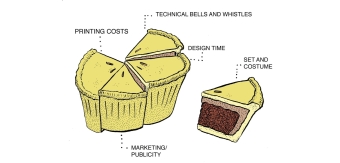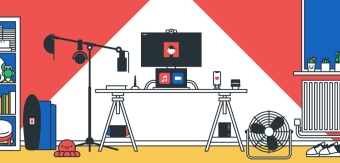Negotiating rates for creative work is a fine art that’s been complicated even further in recent years by AI. Securing fair compensation goes beyond just balancing the books though.
It’s about recognising the worth of your craft and establishing a solid professional foundation. Otherwise, you could find yourself in a situation where you’re working yourself to the bone for peanuts and that benefits nobody as the work is unlikely to be of decent quality if you’re churning it in such vast quantities.
Mastering negotiation is crucial for freelancers and this guide will explore techniques for negotiating higher rates, handling objections, and building long-term client relationships, setting you on a path to flourish in the creative sector.
1. Understanding and Demonstrating Your Value

Marta Kubicka (Marta Mak)
Know Your Worth
Before entering any negotiation, it’s crucial to understand your market value. Research industry standards within the UK for your specific field—whether you’re a graphic designer, copywriter, or filmmaker. Resources such as the Design Business Association or industry-specific salary surveys can help benchmark your rates.
Build a Robust Portfolio
A compelling portfolio is your strongest argument for higher rates. Showcase a diverse range of projects that highlight your skills, versatility, and ability to deliver results. Include case studies or testimonials that demonstrate your impact, such as increased engagement, sales, or brand awareness for previous clients.
Quantify Your Contributions
Whenever possible, translate your creative work into quantifiable results. Metrics like improved conversion rates, audience growth, or enhanced brand presence make a tangible case for your value. Clients are more inclined to agree to higher rates when they see the potential return on investment.
2. Techniques for Effective Negotiation
Start with a Range
When quoting your rates, offer a range rather than a fixed figure. This demonstrates flexibility and leaves room for negotiation while anchoring the discussion at a higher starting point. For instance, instead of quoting £3,000, say £3,000-£4,000. Ensure the lower end of your range is still acceptable to you.
Justify Your Rates
Articulate why your rates are set at a certain level. Break down the cost in terms of hours required, the complexity of the project, and the value you bring. Use phrases like, “Based on the scope and the detailed work involved, my rate is…” to guide clients through your reasoning.
Leverage Anchoring
Psychological tactics like anchoring can be effective. Start negotiations with a higher rate than what you expect to settle for. This makes your final, slightly lower offer seem more reasonable in comparison. For example, if you aim to charge £5,000, start the discussion at £6,000.
Create Packages
Offering tiered packages gives clients options and can often lead to upselling. A basic, standard, and premium package approach allows clients to choose a level of service that fits their budget while understanding the value of investing more. Each package should clearly outline what’s included, with the premium option offering the most comprehensive service.
3. Handling Objections with Confidence

Listen and Acknowledge
When clients object to your rates, listen carefully to their concerns without interrupting. Acknowledge their point of view before presenting your counter-arguments. This demonstrates empathy and positions you as a collaborator rather than a hard-nosed negotiator.
Address Budget Constraints
If budget is a major concern, explore alternatives rather than immediately lowering your rate. This might involve adjusting the project scope, extending the timeline, or breaking the project into phases. Offer to revisit the budget allocation at a later stage when results have been demonstrated.
Show Flexibility
Flexibility doesn’t mean compromising on your worth; it means finding creative solutions. Consider offering additional value rather than cutting rates—such as extended support or an additional round of revisions. This adds perceived value without eroding your rate integrity.
Provide Evidence
If a client is unconvinced about the rate, provide evidence of your previous successes and the typical rates within your industry. Case studies and testimonials can reinforce your stance. An informed client is more likely to appreciate the fairness of your proposed rate.
4. Building Long-Term Client Relationships
Be Transparent
Honesty and transparency build trust. Be upfront about your rates, processes, and any potential additional costs. Clients appreciate clarity and are more likely to respect your pricing structure when they understand the rationale behind it.
Maintain Open Communication
Regular, clear communication fosters strong client relationships. Keep clients updated on progress, involve them in key decisions, and seek their feedback. This not only makes the client feel valued but also reduces the likelihood of misunderstandings or conflicts over scope and cost.
Offer Consistent Quality
Delivering high-quality work consistently is the best way to justify your rates. Meeting or exceeding expectations ensures that clients see the value in paying premium rates for your services, which can lead to repeat business and referrals.
Seek Feedback
Request feedback after each project to understand what you did well and where you can improve. Use this feedback to enhance your services and negotiation strategies. Clients who feel heard and valued are more likely to engage with you on future projects at favourable rates.
AI’s Impact on Price Negotiations

John Holcroft
1. AI-Driven Market Analysis
AI tools can analyze vast amounts of market data, providing insights into industry trends, pricing benchmarks, and demand fluctuations. These tools can help you set competitive rates based on real-time data rather than relying solely on traditional methods or outdated information. For example, platforms like FreelanceRate or Bonsai use AI to offer freelancers rate suggestions based on their skills, location, and experience level.
2. Enhanced Proposal Customization
AI can assist in crafting personalized proposals by analyzing client data and past interactions. Tools like Grammarly and Proposify use AI to optimize language and tone, making your proposals more compelling and tailored to each client. This can improve your negotiation power by presenting a well-articulated value proposition that resonates with the client’s specific needs and preferences.
3. Predictive Analytics
AI-driven predictive analytics can forecast client behavior and budget trends, allowing you to anticipate objections and prepare counterarguments more effectively. Understanding potential sticking points before they arise enables you to address them proactively, making your negotiation process smoother and more strategic.
4. Automated Administrative Tasks
AI can automate routine administrative tasks such as contract generation, invoicing, and follow-up emails. This frees up your time to focus on the creative and strategic aspects of your work. Tools like HoneyBook and FreshBooks streamline these processes, ensuring accuracy and efficiency, which can enhance your professionalism and reliability in the eyes of clients.
Working with AI, Not Against It
1. Integrate AI into Your Workflow
Incorporate AI tools into your creative and business processes to enhance efficiency and accuracy. Use AI for tasks like market analysis, proposal writing, and client communication to save time and improve the quality of your outputs. For example, AI-powered project management tools like Asana or Trello can help you keep track of project timelines and client interactions, ensuring you meet deadlines and maintain strong client relationships.
2. Use AI for Upskilling
AI can also be a valuable resource for continuous learning and skill development. Platforms like LinkedIn Learning and Coursera offer AI-driven personalized learning paths based on your career goals and industry trends. Staying updated with new tools and techniques can give you an edge in negotiations, demonstrating your commitment to delivering cutting-edge creative solutions.
3. Balance AI with the Human Touch
While AI can streamline many aspects of your work, maintaining a human touch in client interactions is crucial. Use AI insights to inform your strategy but ensure that your communication remains personal and empathetic. Building rapport and trust with clients often requires a nuanced understanding of their needs, which AI can support but not replace.
4. Monitor Ethical Considerations
As you integrate AI into your workflow, be mindful of ethical considerations, such as data privacy and algorithmic bias. Ensure that the AI tools you use comply with relevant regulations and industry standards. Transparently communicate to clients how you use AI to enhance your services, reinforcing your commitment to ethical practices.
Final Thoughts
Negotiating better rates for creative work is an ongoing process that combines self-awareness, strategic communication, and relationship-building.
By understanding your value, utilising effective negotiation techniques, and fostering strong client relationships, you can not only secure fair compensation but also elevate your standing in the creative industry.
Remember, the goal is to create a win-win situation where both you and your client feel satisfied and respected.





